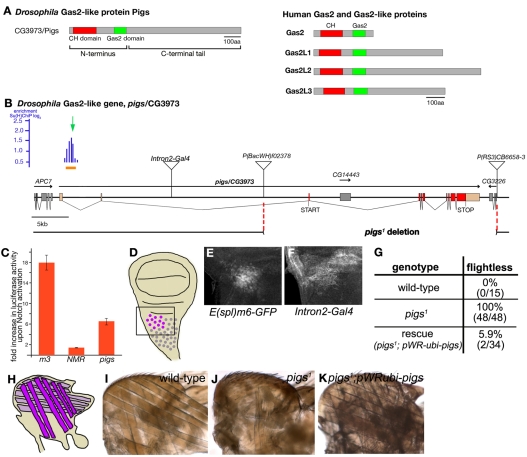Fig. 1.
CG3973 (pigs) encodes the Drosophila orthologue of the Gas2-like protein family and is a downstream target of Notch signalling. (A) Protein domain structure of the fly Gas-like protein CG3973 (Pigs) in comparison with the four human Gas2-like proteins. (B) Gene locus of pigs. P-element insertions are indicated by triangles. The deletion in the pigs1 allele is shown below the sequence. Also shown is the region identified to contain binding sites for Su(H) (Krejci et al., 2009): blue bars indicate oligonucleotides hybridizing to enriched fragments in ChIP (height of bars indicate enrichment; AvgM log2, 0.3 to 2.3). (C) In S2 cells the pigs intron 1 region (‘pigs’), indicated by the orange bar in B, is sufficient to drive luciferase expression from a fusion construct in the presence of the Notch intracellular domain (NICD). Expression is compared to a known target of Notch, E(spl)m3 (‘m3’), and a mutated Notch responsive element (‘NMR’). Values are fold-activation relative to enhancer expression in the absence of the NICD. (D) Diagram depicting the region of myoblast precursors in third instar wing disc. The box indicates the areas shown in E and F. (E) Expression of a Notch activity reporter, E(spl)m6-GFP in the myoblast region of a wing disc. (F) A Gal4 trap P-element insertion into the second intron of pigs, Intron2-Gal4, reveals that pigs is expressed in the myoblast precursor region. (G) pigs1 mutant adults are flightless, but flight is restored when a ubiquitous pigs cDNA is expressed. (H) Schematic of the adult indirect flight muscles (both D and H modified from Sudarsan et al., 2001). (I-K) Indirect flight muscles severely degenerate in a pigs1 mutant (J) compared with wild-type (I) and this degeneration can be rescued by ubiquitous overexpression of a pigs cDNA (K).

